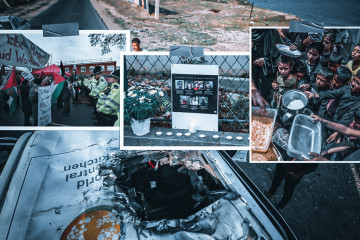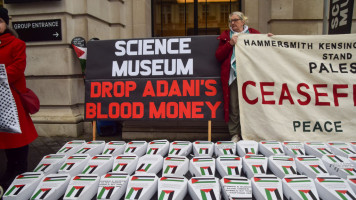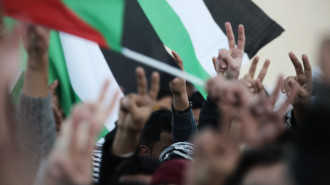
'Abuse is never simple': Meet the advocacy groups taking on South Asian domestic violence

When Pakistani American photographer Sania Khan was murdered by her ex-husband Raheel Ahmed, it sent the whole world into outrage.
From South Asian women’s charities in the US to women’s rights organizations in Pakistan to celebrity authors like Elif Shafak, there was a slew of support for the young woman who had lost her life in this horrifying encounter.
In the aftermath, Sania Khan’s friends gathered to support her memory as best as they could – holding memorials and even starting a scholarship fund in her name.
A few months after her death, her parents filed a wrongful death suit against her apartment building, because Ahmed had been allowed into the building without a security check which is how he managed to get to Khan.
The outrage over being unable to protect Khan in her final moments is undoubtedly valid but what of all the times she’d been left unprotected against the same threat before?
"For women of colour, who have to additionally deal with cultural or religious barriers to seeking help, immigration fears, and even police brutality - intervention in domestic violence takes even longer, and in cases like Khan’s, never shows up at all"
According to the National Coalition Against Domestic Violence,(NCADV) nearly 20 people per minute are physically abused by an intimate partner in the United States, and the restrictions brought on by the pandemic increased domestic violence by 8%.
For women of colour, who have to additionally deal with cultural or religious barriers to seeking help, immigration fears, and even police brutality – intervention in domestic violence takes even longer, and in cases like Khan’s, never shows up at all.
"Individuals without citizenship status or other forms of documentation may face heightened risks as a result of factors like language, social isolation, lack of information or financial resources, cultural beliefs, or fear of deportation and Survivors, especially those of colour, may distrust of government agencies or law enforcement,” says Ruth Glenn, President of Public Affairs for NCADV.
— The New Arab (@The_NewArab) February 1, 2023 |
Aysha*, a 30-year-old volunteer at her local domestic violence shelter in New York said that despite not having any connection with Khan, seeing her story gave her the strength to push her aunt into leaving her abusive relationship.
“Sania did everything she could to get help and she was left alone. I didn’t want my aunt to end up the same way,” she says while talking about how her aunt was sceptical of seeking help because she’d never been financially independent and also struggled with English. For many women of colour, and immigrants in particular, access to culturally or religiously accommodating resources and justice can be limiting.
“We recently had a case where a judge refused to wait for an interpreter in a restraining order case. Without us, the monolingual-Spanish-speaking survivor would have had no idea what happened and how to proceed. We are working to ensure that courts and government agencies across this nation, who are mandated to provide access to their services across languages, do so and do so in a way that meets real survivors’ needs,” shares Patti Tototzintle, President and CEO of Esperanza United, an organization focused on helping Latina survivors of GBV.
Khan had filed for divorce after a slew of threatening behaviour from her then-husband which culminated in him trying to jump out the window and pull him out with her. The situation had only gotten so bad because despite Khan reaching out for help to her family and community, she’d been pressured to stay in the marriage.
In the absence of community support Khan took to TikTok to share her struggles, talking about how going through a divorce as a South Asian woman makes you feel like you failed your community.
Khan isn’t the only one to have to deal with loneliness in the face of an abusive relationship. Trauma therapist Stara Shakti points out “there needs to be more awareness of GBV and the kinds of things that happen behind closed doors that aren't talked about in the light of day. Introducing therapy in South Asian communities would help a lot - I know there's a lot of stigma around GBV and abuse and neglect.”
"To generalise one particular aspect that all women in South Asia and other nations experience is the patriarchal culture that prevents women from realizing their full potential as human beings at the same time discriminating against them both structurally and practically"
Despite there now being some south Asian-focused organisations and advocacy groups that help survivors of domestic violence, there are still a lot of gaps in survivors getting help.
Maitri is one of the organizations founded to bridge that gap. “Last year we witnessed Sania Khan, Gurpreet Kaur Dosanjh, Mandeep Kaur and many others in the US fall victim to domestic violence. In each of these cases, there were red flags long before the ultimate incidents and unfortunately, immediate families in these cases either gave a blind eye or accelerated the abuse. The community did not come forward either to address this. Even after the incidents, we failed to have conversations unwrapping the violence and silence that took place,” says Zakia Afrin, Director of Survivor Advocacy and Violence Prevention at Maitri.
— The New Arab (@The_NewArab) February 20, 2023 |
Community-based practices and traditions can often pose a challenge when it comes to taking a stand against their beliefs but working against community traditions only risk alienating communities of colour even more.
"Outsiders may see our communities as violent or deficient, but we do not. Latina communities, like all communities, are certainly imperfect but we have a rich culture and deep traditions to draw from. And I believe it is from these practices that we will finally build a world without violence,” Tototzintle says.
So much of the existing system is rigged against anyone who may appear to be an outsider. Whether it’s refugees, immigrants, or even just anyone who looks different – help may look very different to them. Many shelters are not able to accommodate women who may have more children and therapists may struggle to understand cultural norms.
But beyond awareness, it is equally also about how the day-to-day disparities add up to put women of colour at a disadvantage. Glenn, who shares that she is also a survivor, points out the need for not just more accessible programs for survivors but also providing financial support or micro-grants, gun control and access to healthcare.
As communities and hopefully support systems for survivors, it’s crucial to be able to help, but help isn’t always easy. “The important thing to remember in all cases of DV is it’s not always clear how best to respond when you see warning signs of abuse. There’s a strong instinct to “save them” from an abuser, but abuse is never simple,” Glenn says while Shakti adds that unreasonable fear and responses like cowering can be a sign that someone may be being abused.
“To generalize one particular aspect that all women in South Asia and other nations experience is the patriarchal culture that prevents women from realizing their full potential as human beings at the same time discriminating against them both structurally and practically,” says Afrin. As many women come out of pandemic restrictions after being stuck with their abusers, struggling financially and having little to no access to any sort of help, it’s crucial to re-evaluate just how we view survivors and why it takes someone losing a life to make us realize our system is wrong.
Anmol Irfan is a freelance journalist with bylines in VICE, HUCK, and The Guardian among others. She has experience writing on minority politics, activism, and gender issues. She is also the founder of the Pakistani community platform, Perspectives Magazine.
Follow her on Twitter @anmolirfan22


